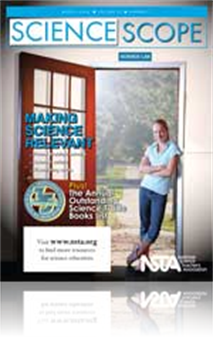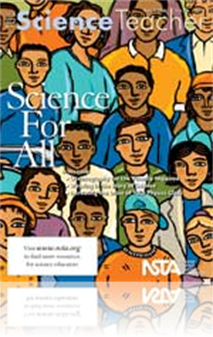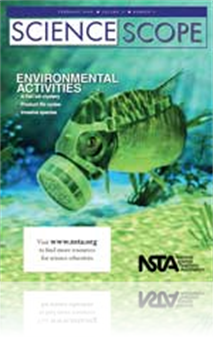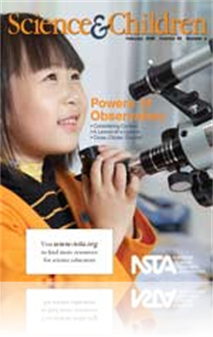All Resources
Journal Article
After the Bell: Water harvesting II: Working toward being green
As you have read in the previous After the Bell column, water harvesting is a process of diverting and collecting rainwater. One of the main reasons to harvest rainwater is to reduce the demand on local sources of water. The objective of the harves...
Journal Article
Bumpy, Sticky, and Shaky: Nanoscale Science and the Curriculum
Nanoscience, or the study of the world at the size of a billionth of a meter, has the potential to help students see how all of the sciences are related. Behavior of materials at the nanoscale differs from materials at the macroscale. This article in...
Journal Article
Safer Science: Geology—Rock Solid Safety
Although perceived as having a lower level of safety issues compared to chemistry or biology laboratories, Earth-space science and geology classes have their share of challenges. In fact, a number of safety concerns exist, which need to be addressed ...
Journal Article
Science Sampler: Wade in the water—School, parent, and community collaboration
Real-life science experiences can excite students. Both the American Association for the Advancement of Science (AAAS) and the National Research Council (NRC) stress the importance of hands-on activities that foster inquiry-skill development. One suc...
Journal Article
Sounds Like Success: A Framework for Equitable Assessment
Teachers have many dilemmas when it comes to assessing a classroom of diverse students. Teachers need to find out what students really know while being fair to all students. They also need to learn how to alter assessments without watering down conte...
Journal Article
Scope on the Skies: Deep-sky objects
Beyond the region of our solar system is the rest of the Milky Way galaxy, and of course the rest of the universe. To the amateur astronomer or casual observer, the phrase deep-sky objects is a reference to those dim celestial objects that are beyond...
Journal Article
Tech Trek: The collaborative works of wikis
Wikipedia is part of a new generation of public documents—collectively known as wikis—to which many different writers may make contributions. Due to the collaborative nature of wikis, controversy flares up from time to time about the veracity or ...
Journal Article
Tried and True: Investigating ecosystems in a biobottle
Biobottles are miniature ecosystems made from 2-liter plastic soda bottles. They allow students to explore how organisms in an ecosystem are connected to each other, examine how biotic and abiotic factors influence plant and animal growth and develop...
Journal Article
Ask the Experts: February 2008
This month’s column addresses the following question: How did the Cartesian diver (devil) get its name? ...
Journal Article
Perspectives: Learning to Observe <em>and</em> Infer
Researchers describe the need for students to have multiple opportunities and social interaction to learn about the differences between observation and inference and their role in developing scientific explanations (Harlen 2001; Simpson 2000). Helpin...
Journal Article
Science 101: How does a telescope work?
It turns out that telescopes, microscopes, and binoculars all work on the same principles, so you get three for one in this answer. They give us information that we can’t get with the unaided eye. To do that, these devices gather as much informatio...
Journal Article
The Fish Kill Mystery: Using Case Studies in the Middle School Classroom
Case studies are an excellent method for engaging middle school students in the current work of scientists. Students learn to think like scientists as they decide how to investigate the dilemma presented in the case study. This article describes one ...
Journal Article
A Walk in the “Tall, Tall Grass”
This inquiry-based lesson was inspired by Denise Fleming’s book entitled, In the Tall, Tall Grass (1991). The author used the book and a real study of prairie grasses to teach kindergartners how to make careful observations and record what they see...
Journal Article
In this science investigation based on the 5E learning model, students moved through four different centers designed to focus their attention on the concepts of mass, volume, and density. At these stations, students encountered discrepant events that...
Journal Article
Safer Science: SC3 = Formula for Chemical Management
The aim of the Environmental Protection Agency’s (EPA) “Schools Chemical Cleanout Campaign” (SC3) is to ensure that all schools are free from hazards associated with mismanaged chemicals, including science laboratories. SC3 gives schools inform...
Journal Article
Children’s descriptions of commonplace objects and events of life are often limited because they do not provide adequate information about the context of their observation. Encouraging primary and early intermediate students to consider the context...
Journal Article
Scope on Safety: There’s no such thing as a free gift
With shrinking budgets, increasing enrollments, aging equipment, and major advances in technology, donations are one way that science departments can help ends meet. However, many donations can be more trouble than they are worth. To help avoid any s...
Journal Article
How Do Our Actions Affect Water Quantity and Quality?
Water is an essential resource for all living things. How we live on our watershed can impact water quantity and quality. It is important to recognize how humans alter watershed dynamics, but students often find it challenging to visualize watershed ...
Journal Article
Zoos and similar non-school sites have the added advantage of getting students out of school and into another environment, demonstrating that science learning can take place anywhere—not only in formal school settings. Through the animal behavior p...
Journal Article
Editor’s Note: Teaching Observation—Aim Higher
Observation is a fundamental process in science. It is a skill that many science curricula emphasize. It seems like such a simple skill, but observation skills are not quite so simply mastered. Like anything else, just watching and observing does lit...
Journal Article
There’s More to Light Than Meets the Eye
This investigation was part of a multi-lesson unit that gave students direct experience using increasingly sophisticated tools to make more detailed observations and measurements of light. Through these lessons, students experienced a key aspect of t...
Journal Article
Place-Based Investigations and Authentic Inquiry
In place-based inquiry, the context of an investigation involves a place about which students already have some interest, curiosity, or knowledge. Their interest makes the application of scientific investigation and inquiry techniques more meaningful...
Journal Article
Science Shorts: Observation Versus Inference
When you observe something, how do you know for sure what you are seeing, feeling, smelling, or hearing? Asking students to think critically about their encounters with the natural world will help to strengthen their understanding and application of ...
Journal Article
Editor’s Roundtable: At the breaking point
Sobering articles and alarming predictions about the environment appear in magazines, journals, and the media daily. These warnings should not be overlooked and are a call to action for educators. Our students must learn to think of themselves as mem...
Journal Article
In the late 19th and early 20th centuries, nature-study was the most widespread orientation to science instruction in the nation’s schools. During the four or so decades of its existence, nature-study evolved to become both a common body of knowled...
Journal Article
Editor’s Corner: A Return to Nature
In the recent book by Richard Louv, Last Child in the Woods (2005), he suggests that, for the first time in human history, young people today are growing up with little or no meaningful contact with the natural world. Louv cites various causes for th...







